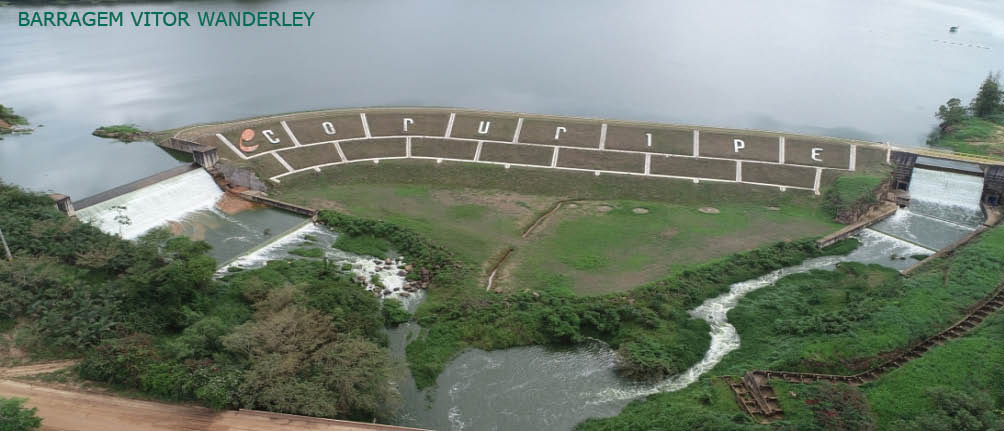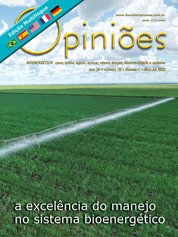José Marcos Jorgi
Diretor Agrícola do Grupo Coruripe
OpAA76
Operações integradas sob diferentes condições
O Grupo Coruripe tem três tipos distintos de manejos agronômicos devido às características distintas dos nossos três polos de produção (Coruripe-AL, Campo Florido-MG e Iturama, Limeira D’Oeste e Carneirinho-MG). Para a safra 23/24 teremos uma área de produção de 192.054 ha e uma produção estimada de 15 milhões de toneladas de cana de açúcar.
Polo Coruripe:
Com a escassez de áreas de expansão e por estar contida em um ambiente de produção restritivo, investimos muito em soluções agronômicas que verticalizassem nossa produção, e a mais expressiva delas foi a irrigação. Hoje possuímos 25.000 ha de canaviais irrigados (gotejo, pivô e aspersão), que permitem um ganho médio de produtividade na ordem de 23% sobre as áreas de sequeiro. Nessas áreas irrigadas, podemos manejar a época ideal da colheita de forma a priorizar o corte das áreas de sequeiro no início de safra (época mais úmida) deixando as canas irrigadas para serem colhidas do meio para o final da safra.
Com a escassez de áreas de expansão e por estar contida em um ambiente de produção restritivo, investimos muito em soluções agronômicas que verticalizassem nossa produção, e a mais expressiva delas foi a irrigação. Hoje possuímos 25.000 ha de canaviais irrigados (gotejo, pivô e aspersão), que permitem um ganho médio de produtividade na ordem de 23% sobre as áreas de sequeiro. Nessas áreas irrigadas, podemos manejar a época ideal da colheita de forma a priorizar o corte das áreas de sequeiro no início de safra (época mais úmida) deixando as canas irrigadas para serem colhidas do meio para o final da safra.
Temos também a opção de irrigar as áreas de plantio de verão (dezembro a março) por ser um período em que as ocorrências de chuvas são menores. Na fertirrigação são utilizados três sistemas de aplicação: localizada, aspersão via caminhões e aspersão via canais e adutoras. Outro avanço que vem ao encontro da irrigação, foi a implementação da colheita mecanizada, pela qual o palhiço remanescente da colheita transforma-se em um verdadeiro colchão protetor dos solos, mantendo a umidade, o aumento dos níveis de matéria orgânica e o controle de ervas daninhas nesses ambientes tão restritivos.
Paralelamente, fazemos um trabalho de conscientização dos nossos fornecedores em conjunto com a Associação dos Fornecedores de Cana de Coruripe (responsáveis por 35% da matéria prima desta unidade) para adoção deste tipo de colheita, tendo em vista que nossos tabuleiros são ideais para uma boa performance dos equipamentos e à crescente escassez de mão de obra necessária ao corte da cana ao longo das últimas safras.
Um aspecto delicado na unidade é o manejo varietal. Apesar dos convênios com as entidades de pesquisa na busca de materiais promissores, temos um grande trecho a percorrer quando comparamos com a diversidade de variedades consolidadas no Centro-sul.
Hoje nosso censo varietal possui um grau de vulnerabilidade muito alto, e isso nos preocupa muito, pois as liberações de variedades promissoras estão em um ritmo aquém de nossas necessidades. No preparo de solos, é utilizado o sistema de cultivo mínimo com rotação de culturas (crotalária e feijão). No caso do feijão, trata-se de um projeto social junto aos municípios da região onde a Usina cede as áreas de reformas já preparadas e as comunidades carentes executam o plantio e a colheita do feijão; na sequência, a usina fecha com o plantio de cana. Esses projetos beneficiam atualmente 950 famílias.
Hoje nosso censo varietal possui um grau de vulnerabilidade muito alto, e isso nos preocupa muito, pois as liberações de variedades promissoras estão em um ritmo aquém de nossas necessidades. No preparo de solos, é utilizado o sistema de cultivo mínimo com rotação de culturas (crotalária e feijão). No caso do feijão, trata-se de um projeto social junto aos municípios da região onde a Usina cede as áreas de reformas já preparadas e as comunidades carentes executam o plantio e a colheita do feijão; na sequência, a usina fecha com o plantio de cana. Esses projetos beneficiam atualmente 950 famílias.
Polo Campo Florido:
Campo Florido é nossa maior unidade, com capacidade para esmagar 4,2 milhões de toneladas de cana por safra, e a particularidade de ser abastecida por 100% da cana proveniente de fornecedores.
Campo Florido é nossa maior unidade, com capacidade para esmagar 4,2 milhões de toneladas de cana por safra, e a particularidade de ser abastecida por 100% da cana proveniente de fornecedores.
Ela está localizada na região de Campo Florido, MG, e conta com um ambiente de produção bastante favorável (latossolos vermelhos, vermelho-amarelos e amarelos – ambientes B, C e D) e histórico de precipitações anuais de 1.710 mm.
Com o apoio técnico da Associação dos Fornecedores de Cana local e acompanhamento da nossa equipe agrícola, os 50 fornecedores são orientados sobre os manejos agronômicos ideais para o desenvolvimento de suas lavouras. Alguns pontos de destaque são as utilizações dos subprodutos da indústria como a vinhaça e a torta de filtro. No caso da vinhaça, a operação de fertirrigação (aspersão) é feita pela usina, e as aplicações da vinhaça enriquecida e localizada são executadas pelos próprios fornecedores. Já a torta de filtro é cedida pela Usina, e cada fornecedor é responsável pelos processos de compostagem e aplicação na lavoura.
Nas áreas de preparo de solos, a rotação de cultura com soja é uma prática comum, abrangendo praticamente 100% das áreas de reformas e expansões. Após o término da colheita de grãos, os fornecedores iniciam as campanhas do plantio de cana-de-açúcar, respeitando-se as melhores técnicas de manejos e o período ideal para executar essas operações. A combinação desses fatores, aliados ao potencial de produção da região, tem gerado produtividades de 13.000 kg de ATR/ha ao longo das últimas safras.
Polo Iturama:
Localizadas na região do Pontal do Triângulo Mineiro, as unidades de Iturama, Carneirinho e Limeira D’Oeste, compõem o terceiro bloco de produção do Grupo, abrangendo uma área de 101.000 ha e a produção de 7,5 milhões de toneladas de cana.
Suas áreas de produções são compostas por 55% de canaviais próprios e 45% de canaviais de fornecedores. Nesse bloco, os fornecedores são amparados tecnicamente pela Associação dos Fornecedores de Iturama e pela equipe técnica da Carteira de Fornecedores da Usina.
Pelo fato de o Polo Iturama estar inserido em um ambiente de produção mais restritivo (59% das áreas estão localizadas em ambientes de produção D e E, e regime pluviométrico de 1.370 mm/ano) a empresa vem investindo em soluções tecnológicas que alavanquem as produtividades de nossos canaviais. Nos últimos anos, têm sido desenvolvidos vários projetos de irrigação e fertirrigação. Em Limeira D’Oeste, foi construída uma adutora pressurizada para vinhaça com 14 km de extensão e implementado um projeto de irrigação por aspersão via carretéis em uma área de 4.500 ha no mesmo bloco.
Na unidade Iturama temos dois projetos em andamento. O primeiro é uma adutora pressurizada “mista” de 34,5 km de extensão e abrangência de 6.200 ha, em que no sentido usina/campo transporta-se vinhaça para fertirrigação e, no sentido contrário, água para irrigação. O segundo projeto que está sendo finalizado é uma adutora para irrigação de salvamento, com capacidade para cobrir uma área de 5.800 ha, e será demandada mediante escassez hídrica. Nas áreas não cobertas pelas adutoras, tem sido feita a fertirrigação com vinhaça enriquecida (nitrogênio, fósforo e boro) e, de forma localizada, através de carretas aplicadoras.
O preparo do solo nesse Polo requer alguns cuidados, principalmente, os relacionados às áreas de expansões no bioma cerrado. Normalmente, as análises de solos recomendam altas doses de corretivos e necessidade de fosfatagens, além do plantio de leguminosas. Mesmo com todos esses investimentos, as produtividades dos canaviais, obtidas nos primeiros ciclos de produção, podem ser insuficientes.
Um outro manejo interessante, e quem tem dado bons resultados, é o plantio da torta de filtro compostada nas áreas de plantio de inverno e meiosis. Normalmente, essas áreas ficam nas adjacências das áreas industriais e, assim, podem ser contempladas com irrigação de águas residuárias e fertirrigação.
Aliadas a todas essas técnicas, devem-se acrescentar um bom planejamento e a execução das atividades dentro das premissas do nosso programa interno de eficiência operacional.





